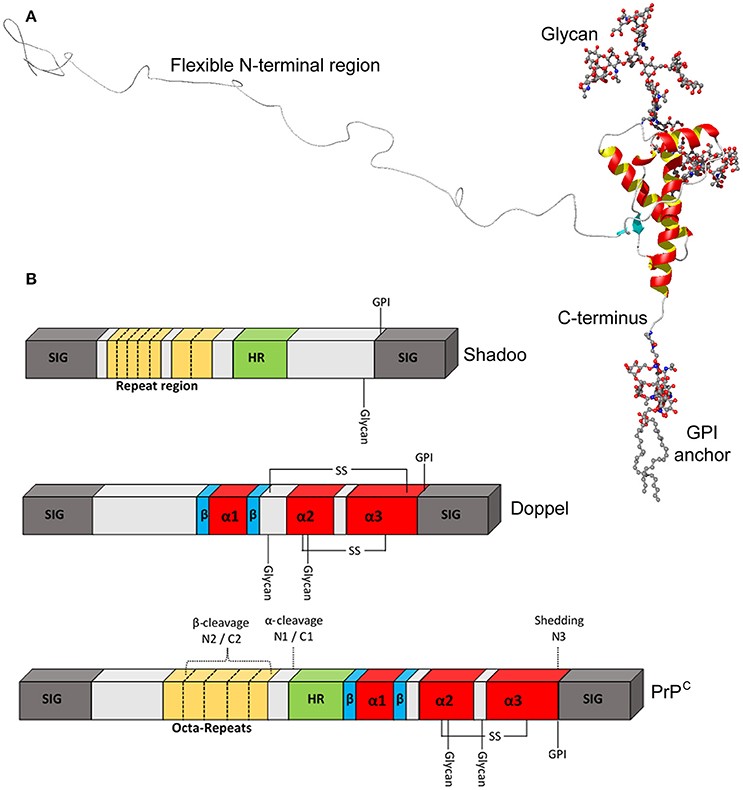What is PRNP Protein
The PRNP protein is encoded by the PRNP gene on human chromosome 20 and has unique properties and significance in the field of molecular biology.
What is PRNP Protein?
The PRNP protein, also known as the prion protein, constitutes a cell surface glycoprotein primarily found in neurons. Its normal, healthy form, PrPC (Cellular Prion Protein), is soluble and participates in various physiological processes. In contrast, the misfolded and aggregated form, PrPSc (Scrapie Prion Protein), is implicated in transmissible spongiform encephalopathies (TSEs). The term "prion" encapsulates its proteinaceous infectious nature, distinguishing it in the molecular landscape.

Figure 1. Structural features of PrPC. Castle, A.R., et al. 2017)
The Function of PRNP Protein
While the precise role of PrPC continues to be elucidated, emerging evidence points to its involvement in neuroprotection, neuronal differentiation, and synaptic function. Additionally, PrPC is intricately linked to cellular copper homeostasis, with its ability to bind copper ions influencing normal cellular function. The neuroprotective effects of PrPC are thought to be mediated through signaling pathways, including the PI3K/Akt pathway, emphasizing its multifaceted role in cellular processes.
PRNP-Related Diseases
The notoriety of the PRNP protein arises from its association with transmissible spongiform encephalopathies (TSEs), a group of neurodegenerative diseases. Creutzfeldt-Jakob disease (CJD) in humans, bovine spongiform encephalopathy (BSE) in cattle, and scrapie in sheep exemplify these debilitating conditions. The pathogenesis involves the conversion of PrPC to PrPSc, triggering the accumulation of misfolded prion proteins, neuronal damage, and characteristic spongy brain tissue.
PRNP Related Signaling Pathways
Deciphering the signaling pathways associated with the PRNP protein unveils its intricate connections within cellular processes. The PI3K/Akt pathway emerges as a key player, with studies suggesting that PrPC modulates this pathway to exert its pro-survival effects. Moreover, PrPC interacts with proteins such as stress-inducible protein 1 (STI1) and laminin receptor precursor (LRP), influencing cell adhesion, apoptosis, and other crucial cellular functions.
Applications of PRNP in Biomedical Research
- Diagnostic Tools
Detection of misfolded prion proteins, particularly PrPSc, serves as a cornerstone for diagnostic tools. Immunohistochemistry and protein misfolding cyclic amplification (PMCA) enable the identification of abnormal prion protein accumulation in tissues, offering crucial insights for early disease diagnosis and monitoring.
- Therapeutic Strategies
Targeting the PRNP protein holds promise for therapeutic interventions in prion diseases. Strategies involve inhibiting the conversion of PrPC to PrPSc, enhancing the clearance of misfolded prion proteins, and modulating neuroprotective pathways. While definitive cures remain elusive, ongoing research endeavors aim to translate these strategies into effective treatments.
- Neurodegenerative Disease Research
Beyond prion diseases, the study of PRNP protein contributes to broader neurodegenerative research. Insights gained may offer valuable perspectives for understanding and developing treatments for conditions like Alzheimer's and Parkinson's diseases, expanding the impact of PRNP protein research.
- Target for Drug Development
The intricate involvement of PRNP protein in cellular signaling pathways positions it as an attractive target for drug development. Small molecules and compounds that modulate PRNP expression, prevent misfolding, or target downstream signaling pathways present potential avenues for therapeutic interventions, reflecting a dynamic frontier in pharmaceutical research.
The PRNP protein, with its dual identity as a cellular guardian and a harbinger of neurodegenerative diseases, unfolds as a subject of profound scientific interest. As our understanding deepens, the applications of PRNP protein in diagnostics, therapeutics, and broader neurodegenerative disease research herald a promising era in biomedical sciences. The pursuit of unraveling the mysteries surrounding PRNP protein continues, offering hope for innovative solutions to longstanding challenges in neurobiology and medicine.
Recommended Products for PRNP Protein
| Cat.# | Species | Product name | Source (Host) | Tag |
|---|---|---|---|---|
| PRNP-373H | Human | Recombinant Human PRNP, Fc-tagged | Human Cell | Fc |
| PRNP-372H | Human | Recombinant Human PRNP Protein, His-tagged | HEK293 | His |
| PRNP-6005H | Human | Recombinant Human PRNP Protein (Gln91-Ser231) | E.coli | Tag Free |
| Prnp-791M | Mouse | Recombinant Mouse Prion Protein, His-tagged | E.coli | His |
| PRNP-4708R | Rat | Recombinant Rat PRNP Protein | Mammalian Cell | His |
| PRNP-1617R | Rhesus monkey | Recombinant Rhesus Monkey PRNP Protein, hIgG1-tagged | HEK293 | hIgG1 |
| Prnp-799B | Bovine | Recombinant Bovine Prion Protein, His-tagged | E.coli | His |
| PRP-01C | Cervid | Recombinant Cervid PRNP Protein, His-tagged | E.coli | His |
| PRP-02C | Cervid | Recombinant Cervid PRNP protein, His-tagged | E.coli | His |
| Prnp-653H | Hamster | Recombinant Hamster Prnp Protein, His-tagged | E.coli | His |
Reference
- Castle, A.R., Gill, A.C. Physiological Functions of the Cellular Prion Protein. Front Mol Biosci. 2017, 4: 19.

